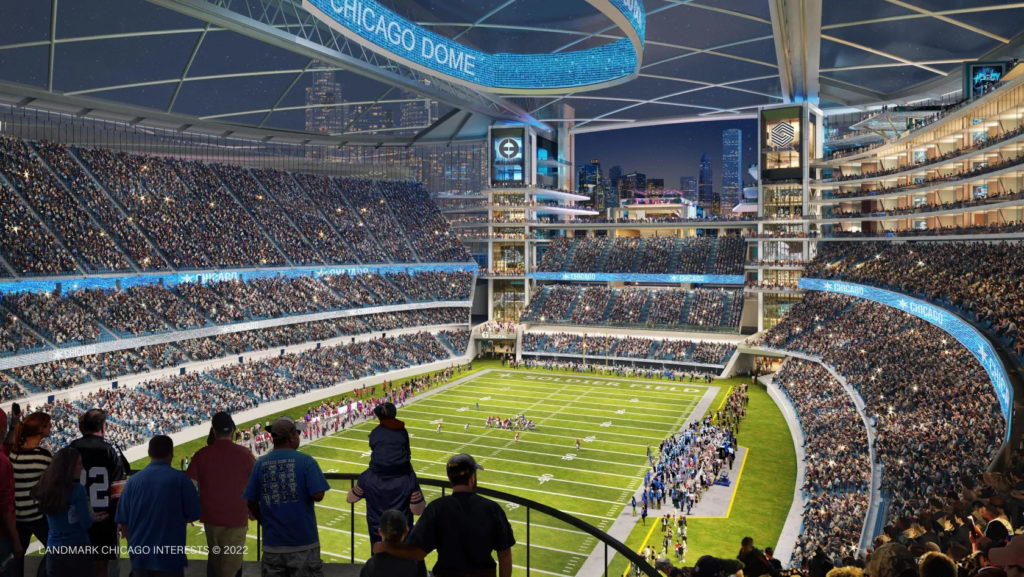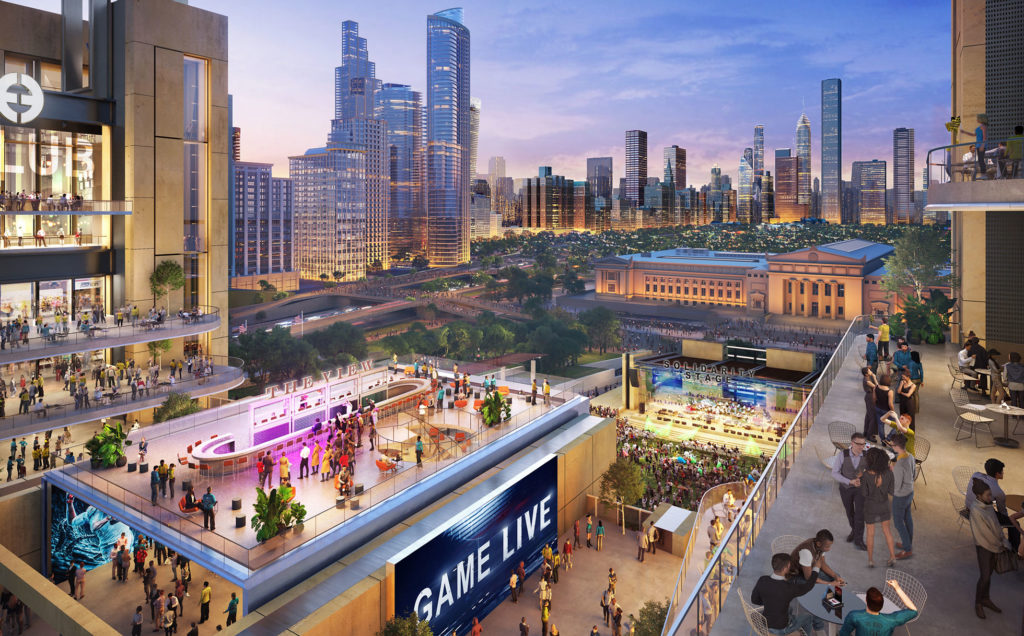
With the Chicago Bears focused on a new stadium development at the Arlington International Park, Mayor Lori Lightfoot outlined three potential changes to the team’s current home, Soldier Field, that may or not keep the NFL in town.
The proposed Soldier Field changes are all still in the early stages, and much will be determined by whether the Bears decided to drop their own Arlington stadium development and decide to keep playing at Soldier Field. But ultimately all three proposals are centered on extending the life of Soldier Field, which first opened in 1924 and extensively remodeled in 2002-2003.
The three recommendations came from the mayor’s Museum Campus Working Group:
- Option 1: Fully enclose the stadium by rebuilding both endzones with columns that can support a dome structure, in hopes of retaining the Bears or luring another NFL team.
- Option 2: Rebuild both endzones with columns to make the stadium dome ready, in hopes of retaining the Bears or luring another NFL team.
- Option 3: Modify Soldier Field to be a multi-purpose stadium better suited for soccer while improving its flexibility to accommodate major concerts and a range of events, including college-football games. This assumes the loss of the Bears.
“An improved Soldier Field will deliver a world-class visitor experience,” Lightfoot said in her comments unveiling the proposals. “Furthermore, any of these proposed renovations will allow Soldier Field to retain its role as an economic engine for Chicago for years to come, as these changes will allow us to keep bringing sports, music and other exciting events to our city.”
“I am excited to share these proposals for Soldier Field,” said Richard S. Price, Executive Chairman of financial services firm Mesirow, and chair of the Museum Campus Working Group. “Any of these options has enormous potential to spur economic growth for Chicago and contribute to making the Museum Campus a global, year-round destination.”

Led by Landmark Development and its president, Bob Dunn, a team of stadium engineers, designers, and financial experts came up with options to maximize the existing footprint of Soldier Field while also accommodating a dome and adding enough seats to reach a 71,000 capacity, past the existing capacity of 61,500. (The magic number for hosting a Super Bowl is 70,000.) Putting a dome on Soldier Field would allow the venue to host other big events like the Final Four.
As noted, options 1 and 2 are designed to maintain Soldier Field a viable NFL stadium. All options include major programmatic changes and concourse space improvements while preserving historical components of Soldier Field, including the colonnades. A group of stadium engineers, designers, and financial experts led by Landmark Development and President Bob Dunn came up with the cost estimate of adding a roof and/or supports ranging from $900M to $2.2B. The argument–which may or not be true–from Lightfoot is that the cost benefit to the Bears of improving Soldier Field versus developing a new stadium on an alternate site would be at least $1B to 1.5B or more. But that’s debatable: U.S. Bank Stadium, home of the Minnesota Vikings and frequently cited as a model of what the Bears would built in Arlington, was built at a cost of $1.129 billion and opened in 2016, and Allegiant Stadium, home of the Las Vegas Raiders, opened in 2020 at a cost of $1.9 billion.
And then there’s the issue of a dome. As shown in these renderings, adding a dome would mean basically adding a separate structure enclosing the current stadium. That’s a pretty massive structure, even by modern stadium standards.
Additional measures to provide new amenities include:
- Expand seating from 61,500 seats up to 70,000 total seats including additional fan activation areas.
- Increase the number of traditional suites from 133 to 140.
- Add six new major club and experiential areas, none of which exist in Soldier Field as it stands today.
- Quadruple the food and beverage square footage from 50,000 square feet to 200,000 square feet.
- Add secondary club and activation areas to as many as 20.
- Dramatically expand the opportunity for major sponsorships and naming rights.
- Create more flexible event space and multi-purpose venues including up to four venues with capacity ranging from 5,000 to 60,000 or more.

Intertwined with the debate over the future of the Bears in town is a discussion over a potential makeover of the city’s 57-acre Museum campus to improve accessibility. Members of the Museum Campus Working Group came up with this recommendation, but there are plenty of arts advocates in town — including some participating in early Soldier Field dome discussions (including Friends of the Parks, a longtime thorn in the side of Chicago officials), who argue an expansion of this size would totally overwhelm the rest of the museum campus — check out how the stadium would loom over the Field Museum in the above rendering — and would welcome the loss of the Bears with a downsized Soldier Field more suitable for pro soccer and smaller events. The Bears did not welcome the proposal with any noticeable enthusiasm, reiterating a July 7 statement issued when the idea of a Soldier Field was raised:
“The only potential project the Chicago Bears are exploring for a new stadium development is Arlington Park. As part of our mutual agreement with the seller of the property, we are not pursuing alternative stadium deals or sites, including renovations to Soldier Field, while under contract.
“We have informed the City of Chicago that we intend to honor our contractual commitments as we continue our due diligence and predevelopment activities on the Arlington Heights property. In the meantime, we remain committed to fulfilling our permit operating agreement at Soldier Field.”
This being Chicago, there are plenty of politics involved. The aforementioned Dunn certainly has plenty of experience developing NFL facilities, and he’s current working on a plan for a new high-rise mixed-use development, One Central, across the rail tracks from Soldier Field. It’s not been met with a lot of enthusiasm from Lightfoot or Illinois Gov. J.B. Pritzker, mostly because of the ask for a $6.5-billion subsidy for the project.
Left conspicuously out of Lightfoot’s presentation: how to pay for any upgrades. She was adamant about not using taxpayer dollars to pay for them, but the city still paying down debt on the $660-million renovation until 2032, there may not be a lot of avenues left. Sports gambling has in general been successful in Illinois, but reportedly one of the reasons why the Bears sought land for their own stadium was the unwillingness of Chicago officials to allow a sports book in the museum complex near the stadium. Naming rights would yield limited results, as veterans would oppose any change to the Soldier Field name (though, interestingly enough, in the past the Bears were OK with the idea).
Lightfoot also discussed the possibility of replacing the Bears with another NFL team. It was not clear whether Lightfoot actually raised the possibility with the NFL or the Bears, but that might be a push. Los Angeles and New York host two NFL teams, but in entirely different circumstances: the team share a stadium. It’s hard to see the NFL signing off on a two-team situation where the teams are competing for sponsorship dollars at two different facilities.
Renderings courtesy city of Chicago.
RELATED STORIES: Bears sign Arlington Park purchase agreement for new stadium, development; Bears eye Arlington Heights for new stadium site
